
草虬 / 茅小浪非宣水墨
WILDERNESS DRAGON / MAO XIAO LANG’S NON-RISE PAPER INK
策 展 人:贾廷峰
Curator:Jia Tingfeng
学术主持:李心释
Academic Consultant: Li Xinshi
展览时间:2018年03月17日—04月20日
Duration: 17th Mar. 2018 — 20th Apr. 2018
开幕酒会:2018年03月17日(周六)15:30
Opening reception: 15:30,17th Mar. 2018
展览地点:太和艺术空间
Exhibition Venue: Taihe Art Gallery
地址:北京市朝阳区酒仙桥路798艺术区2号院B10
Add: B10 798 Art Zone Jiuxianqiao Road Beijing.
Tel: 010-59789856
Email: taiheyishu@163.com
Website: www.taiheart.com
茅小浪的非宣水墨
文/ 李心释
绘画形象的真实性是一个悖论的存在,无论哪种形象,在艺术中只可能是一个创造性的表意符号,当然也可能是很平庸的大众化符号,那么,真实就无从谈起,对真实存在的描摹或再现不是艺术的目的,而是手段,通过它们,或者仅仅是简单地通过它们,艺术的转化获得了表演的快感,呈现了艺术家自身的潜在力量,这才使艺术符号得以确立。逼真是一种炫耀,却与真实无关,所以若将注意力转向表意,艺术家可能对逼真不再感兴趣,而艺术依然是艺术。但是,形象总有真实性的指认一面,这种指认让观者赢得自己对形象的诠释权力,通过指认,绘画形象一部分画中,一部分到了观者自身的经验中,因此,真实性指认是观者的习惯性力量,与艺术的关联度不大。也许,艺术家需要这种指认,甚至有意无意去挑起这一指认,以便使作品较快进入观者的视野,不过这绝不是艺术家的目的,如同佛教徒对待大众信仰者的态度与佛理甚远。艺术的外形有取悦大众的一面,内里却渴求知音,艺术之所以是艺术,完全在指认之外。
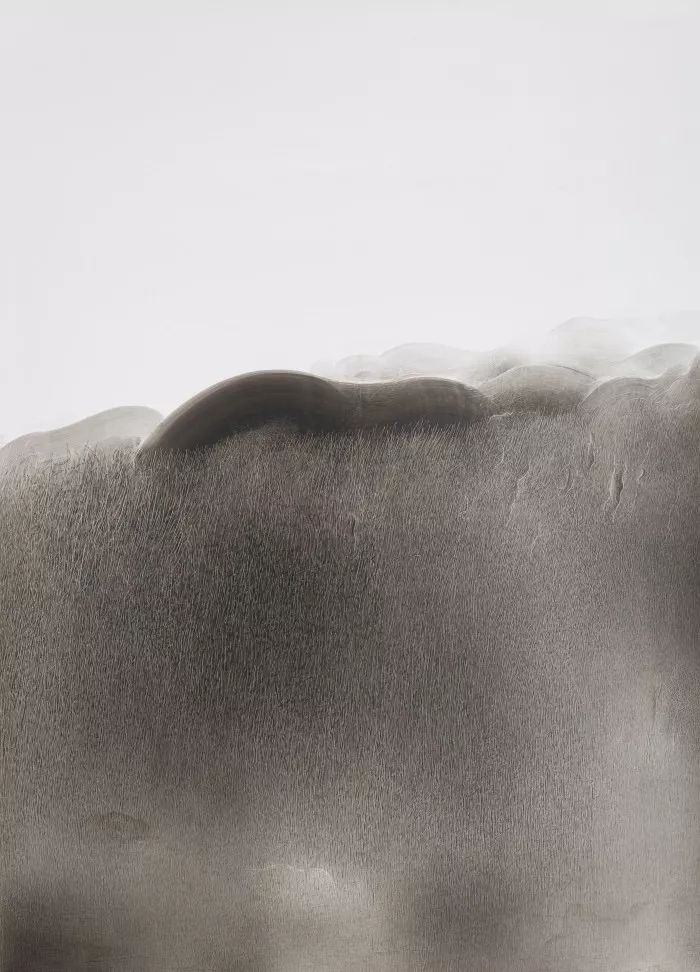
草虬系列 | Wilderness Dragon series
非宣水墨 | non -Chinese Rise Paper and Ink
105x75cm
2017
中国人的言意之辨,成在将视线带离语言固化的概念意义,败在对意义的虚无化,轻视了语言本身作为象的地位。无意义不从符号出,然而,固化的符号却严重遮蔽了新的意义的出现,视觉艺术符号能对语言表意起到很好的反拨与更新作用。中国艺术中的诗画互动传统,对绘画有正反双重影响,它使中国画一开始就重意轻形,对形的指认一产生就偏离了,模糊与变形而呈现出绘画材质要素间的关系力量,占据为画面的中心,外部的真实变得可有可无,它只借助真实形象的一些元素达到形而上的境界;然而语言对绘画的侵蚀也存在,绘画中大部分形而上的内容来自语言,来自诗,来自儒释道的教义,山水画的理想模式大同小异,跟古典诗歌的因袭面貌甚为相似,创作与阐释的语言很成熟,但也很“文化”,往好的角度看,形成了后人难以逾越的高峰,往坏处说,从情绪、意境到语言(包括阐释的语言)都形成了约定俗成的封闭空间,拒斥任何新的现代性经验。
中国艺术在其开端就偏离真实,故没有西方艺术在悖论中的冲突与挣扎,自然也没有西方现代艺术倒向悖论的另一面那种极致与决绝。在中国古代绘画中真实从没有受到质疑,真实形象会自然地过渡到超越性经验,我们可以从古代绘画中发掘出很多近似于现代性的东西,却绝非就是现代性,就像有人谈论“古典诗的现代性”,反而误导人。比如南宋画家牧溪的《六柿图》的抽象、极简,与西方现代画有相通的地方,却不是从对真实形象的否定而来,而是背后有一个理念的模型,以禅宗的法门阐明一种世相。
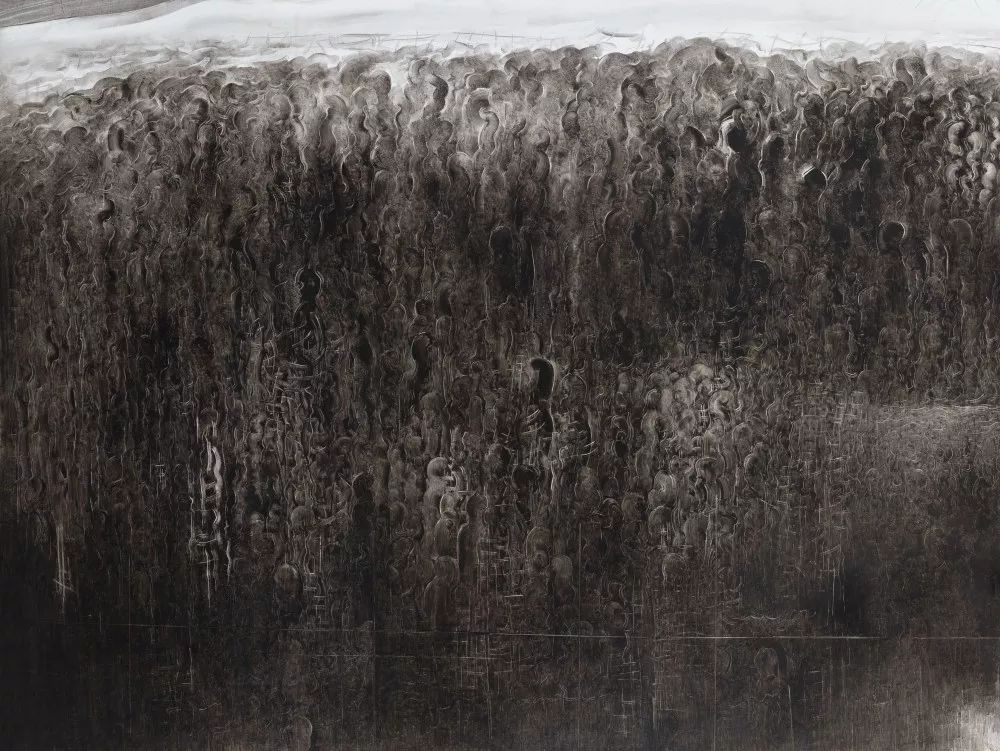
草虬系列 | Wilderness Dragon series
非宣水墨 | non -Chinese Rise Paper and Ink
100x150cm
2009
悖论的另一面是非真实成为真实,其真实的内涵只能是心灵的真实,然而心灵的真实并无从证明,只能靠有效的呈现,靠心灵所创造的可感知的意义来呈现。形象的真实性被一面镜子的反光完全穿透,剩下的只有原生的材质的碎片,不再有固化的语言系统使之重新完整起来,这彻底使形象的约定意义失效,而且使绘画的注意力转向材质的可能性与语境中的语言性上,故而说,现代性绘画走向幻象或抽象,是一种必然。
雷尼·玛格里特的画作《形象的背离》标志着西方绘画走出了真实性纠缠,它以理性与直觉的双重方式宣告以往时代的结束,画中“这不是一个烟斗”(法文),被法国思想家福柯解读为语言与形象、相似与确认的矛盾,形象与事实的相似并不被语言所对等确认。这就意味着形象让位于表达,建立在相似性基础上的真实性是虚幻的。当然,绘画的表达永远不同于语言的表达,玛格里特的作品选择语言文字来否定形象的真实性,显然是无奈之举,也是由于“尽象莫若言”。中国人经过半个多世纪可怕的现实主义革命后,从重意轻形中倒过来走不出追求真与美的困境,未被质疑的真与未被质疑的美,只能是伪真与伪美,为原始的相似律与流行美学观念所控制。
具有现代性意识的绘画读者已经出离画面的造型,因为造型表现很难进入现代性经验中心。绘画的表达仅在于其自身的痕迹,形象变得次要了,甚至会干扰它的表达,即便无意中产生的形象,也会被画家故意模糊或抹去形象,或出其不意地扰乱形象与真实之间的相似性。可是痕迹会很容易被处理成一种非常中国化的概念,画面笼罩着迷濛的虚幻的若有若无的景象,实则为空洞的痕迹,至多成一种拙劣的观念艺术。整体景象是一回事,痕迹是另一回事,痕迹不必然导向“虚薄”,痕迹是差异性特征相当活跃的语言,也像乐句与和声之间的相应,痕迹产生于本质性力量牵引下的游走,“行于所当行,止于所不可不止”。
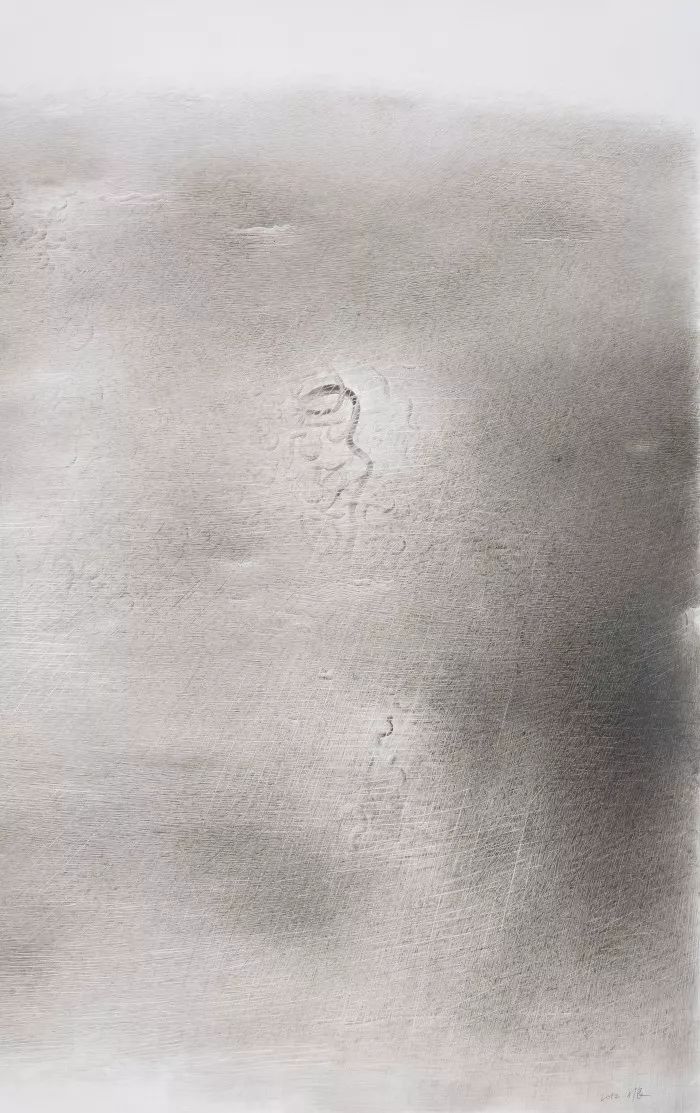
草虬系列 | Wilderness Dragon series
非宣水墨 | non -Chinese Rise Paper and Ink
82x130cm
2012
艺术创造选择哪一种材质,是艺术家的心性与天性中的亲近感,还是文化烙印占比更重?换言之,水墨艺术只适宜中国人做吗?世上没有哪种东西不是从特定的文化土壤里出来,然而为何有些东西会成为普世性的,有些东西不能,后殖民语境可回答之。水墨之所以是水墨,已非简单的绘画媒介,其有深远的哲学意蕴与人性回响,水无形,墨无色,若两仪之于太极,以水墨作画,具有天然的抽象高度,画境可达非有非无、不曒不昧,近于《庄子》之象罔。水墨艺术本来最有可能成为世界性艺术,却沦为颇著中国色彩的地方性艺术,不啻讽刺。
从水墨的内涵出发达到对真实的否定,与现实主义决裂,与一种传统的理想决裂,国人走不出来,意识不到背负所谓的传统,实际上是反传统。传统只可能是创造性的传统,何况水墨的哲学意蕴本就为其设定了开放的边界。85’运动及之后的实验水墨则转向了另一端,将西方绘画观念作为方法来改造水墨,忘却或者无视水墨的特质,貌似给水墨艺术带来无限多的可能性,实则背离水墨精神,如同新诗背离汉语精神一样,成就了西方绘画的一次远行而已。
从外部挪用的方法只是一种套用的假方法,由此方法转嫁而来的现代性也就成了假性现代性,在特殊的社会政治环境中,以反为正,土壤不足或营养缺乏,必导致畸形或生长停滞。西方艺术的演化有西方自身问题的逻辑,是艺术与社会思想、生活、重大事件之间的互动结果,其动力直接萌生于艺术内部的哲学追问。水墨艺术并非简单地按媒介划分的艺术门类,而内含哲学理念与方法,完美可以通过追问与还原,获得符合自身逻辑的更新与创生。水墨哲学表征为对水墨的形而上的追问与本源性的思考,而不是什么死的现成的观念,水墨艺术历史上的东西都只能被放入括号内,这是一种活的哲学,在反思与叛逆中形成一种独特的水墨精神。
水墨痕迹的创生,深入现代性的自由经验,其探索趋于极致,“语不惊人誓不休”,这样的描述仅适用于兼具现代性意识与普世性视野的中国当代画家茅小浪。在水墨哲学之上才有真正的方法可言,茅小浪所走之路开启了中国艺术现代性的自主发生,他对待传统水墨有过一次嵇康“声无哀乐论”一样的去蔽,除了形而上的水墨,传统根本不存在,他使水墨造型的空间性大大削弱,而时间性,或者说水墨的过程与痕迹,成为艺术的中心。
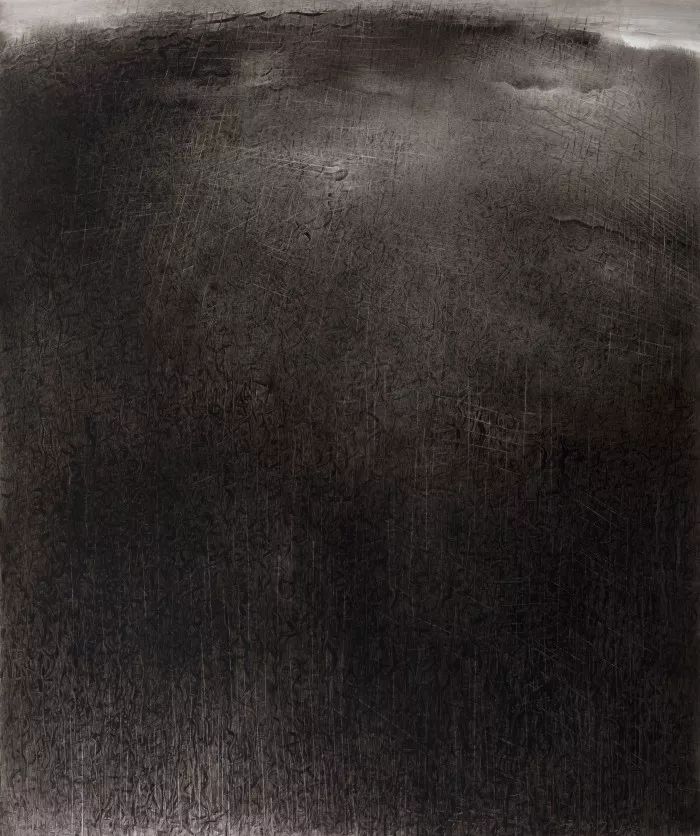
草虬系列 | Wilderness Dragon series
非宣水墨 | non -Chinese Rise Paper and Ink
130x152cm
2010
现代艺术好不容易走到“形象的背离”的地步,艺术中空间与时间的对立面目便渐渐明晰起来,主题从前者向后者漂移。从某个角度看,现代性集中于对存在与时间的关系的反思,与以往不同的时间体验及认知反映了现代性经验的本质特征。茅小浪的水墨创作已进入一种显著的时间现代性范畴,他对自己的艺术实践有完整而清晰的认知,其创作遵循如下轨迹:从水墨哲学到方法,从方法到痕迹,从痕迹到道路,其中,人的本质贯穿其中。他跳过了传统的理想的水墨观念及水墨伦理理想,有勇气不以这个世界为参照,只参照自己,“在自己的痕迹中开辟道路”。这不仅源于富有创造力的艺术家都会有的对新的现代性语境的敏感与投入,更是因为他对中国特殊的社会政治环境对文化土壤无可挽回的破坏有清醒的认识。在现代符号学意义上,痕迹属于一种差异要素的运行,由艺术家直觉所把握的差异关系的细节组成,意义与痕迹同现,而不是后者表现前者,连续的痕迹体现为运行在可感的差异形式之上的气息,可谓之艺术品的生命气息。
西方现代艺术无论变出什么花样,都有一个不可见的形而上的精神维度,没有它,艺术不可能称之为伟大。真正的艺术应是不可见性中的可见性,比如莫兰迪的静物作品、罗斯科的黑色绘画,有一种深刻的不可见性,那么中国有几个艺术家的作品是从“无”中获得作品的合法性的?由于历史语境不同,中国艺术家不可能从西方艺术形式中获得那种超越性,只能沉潜于自身的虚无中生发出精神维度。茅小浪的作品无不向“虚无之有”逼近,都是其生命状态的浸淫之作,创造了一种独有的“立象以尽意”的方式,而不只是出于创作的冲动,在中国,像他这样拥有不可见的精神维度与方法的画家堪称画家中之画家。
总之,茅小浪的水墨艺术解决了与传统、与西方的关系,已不仅仅属于中国,作为艺术家,他的作品也没有中国身份标识,它们熔铸他者的一切可能性,却从无偏离水墨精神。
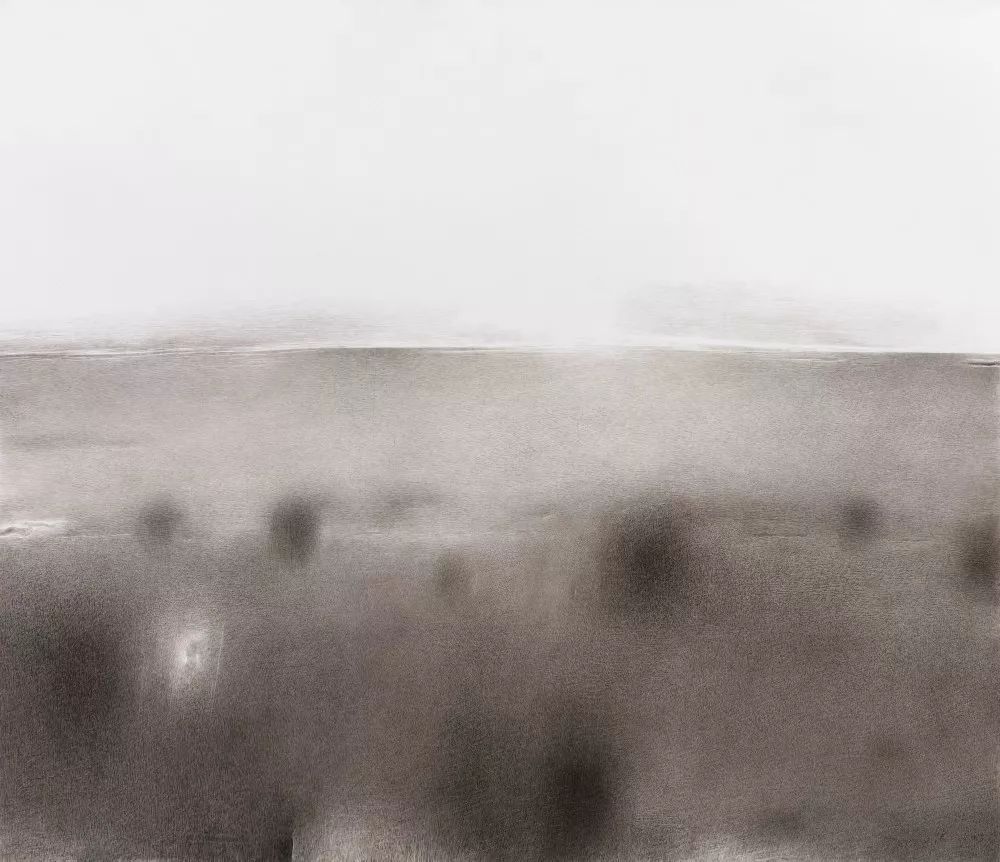
草虬系列 | Wilderness Dragon series
非宣水墨 | non -Chinese Rise Paper and Ink
130x150cm
2015
Mao Xiaolang's non-Chinese Rise Paper Ink
Li Xinshi
Theauthenticity of painting visualize is a paradox. No matter which kind of visualize, it might be a symbol that creative or democratic in art. In that way, the authenticity of painting visualize is out of the question. The depiction of authenticity is not the aim but the method of art. Through depiction, the transform of art is so dramatic that can present potential power of artists, which makes remarkable artistic symbols in their paintings. Thereality is a kind of flaunt, which is not necessarily relevant to the truth.Therefore, if the artist focuses on the appearance of his art works, it turns out that he may no longer interest in the reality, but art is still art.Nevertheless, portrait of art images has its own reality which makes theaudiences capable for portray themselves. A part of portrait of art become theaudience’s experience. So the reality of art is a habitual ability of audiences, which is not relevant to the art. For some reasons, artists needsuch kind of reality. They even point this reality on purpose so that theaudience could see their paintings efficiently. However it definitely is not the aim of artists, just like the attitude of a Buddhist treats believers and Buddhism itself. The appearance of art has element that pleases the public, but inside it craves for friends.
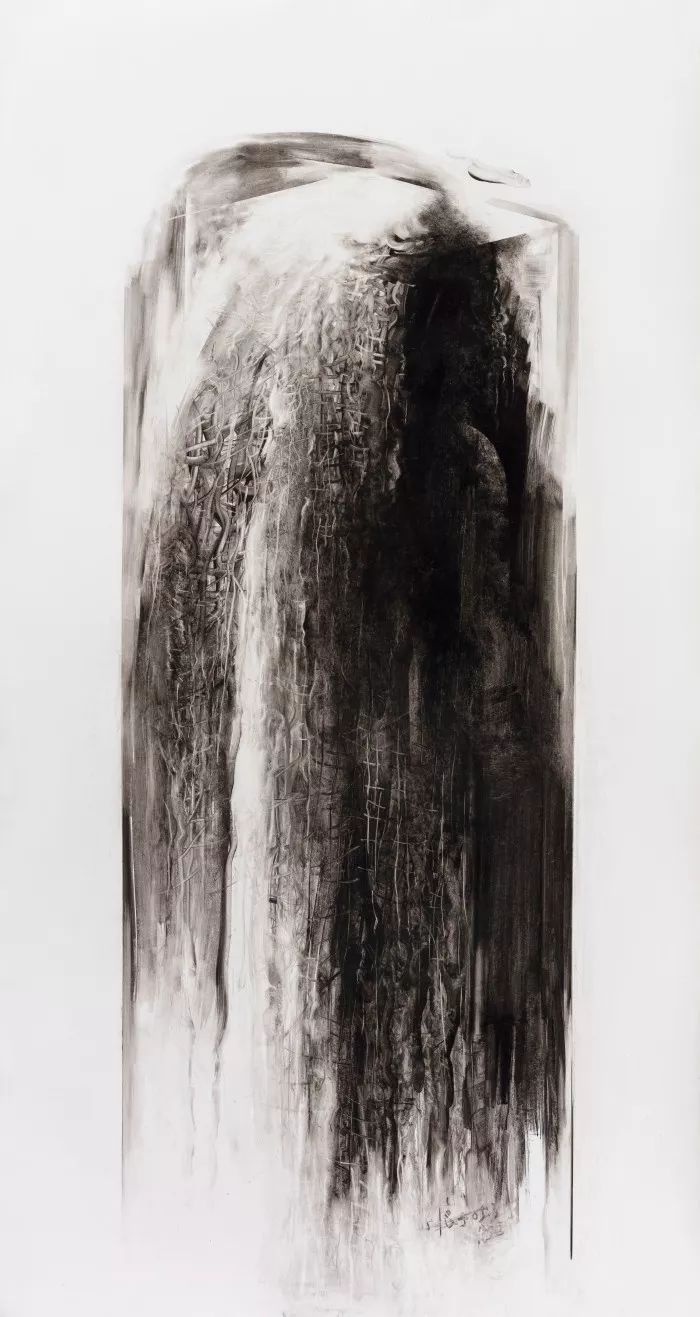
碑痕系列 | Monument Trace series
非宣水墨 | non -Chinese Rise Paper and Ink
130x240cm
2005
Chinese people distinguish language from meaning successfully because they do not look at the concept of language. However it also could be failed because of the nothingness of meaning, and it also underestimates language itself. All meaning come fromsymbols, but the adherent symbols shield the appearance of new meaning. The visual symbols could adjust language efficiently. It is a tradition that poem always interact with paintings in Chinese art. Poem affects paintings in two different ways. From every beginning, it makes paintings value their meaning more than their images. All elements of paintings are related and become the central of painting; they rely on the elements of real appearance for reachingthe metaphysical state. However paintings are eroded by words. Most of contentsin painting are from languages, such as poem and theory of Confucianism. The ideality of landscape paintings is quite familiar with classical poems, its language is mature. To see from a good perspective, it could be a peak that has never been crossed by following people, on the other hand, all elements of paintings have solid emotions, languages and symbols, all of those elements could be a boundary for the new creations.
There is adeviation from reality in Chinese arts. Unlike western arts, it is the reasonwhy there is no struggle and conflict in Chinese arts. There is no doubt that Chinese ancient paintings are real. The real images are beyond experience. Wemight unearth some modern symbols from the ancient paintings, but they are not modernity itself. For example, there is an artist, Mu Xi, from Nansong Dynasty,his “Six Persimmons” is as abstract as western paintings. There is something in common between “Six Persimmons” and western paintings; however, they are not from the denial of real images. There is a true conceptual model to follow.

碑痕系列 | Monument Trace series
非宣水墨 | non -Chinese Rise Paper and Ink
128x244cm
2005
The other side of the paradox is that fantasy can become real, specially reflects the reality of hearts. Although this kind of reality cannot be proved, it must be represented effectively by creating touchable feelings. The reality of images is pierced bythe light of a mirror; it only left pieces of the original materials. There is no more language systems that makes it complete. As results, there is no more meaning of images; what is more, it makes paintings focus on the possibility of material and painting language. Therefore, it is inevitable that modern art sbecome more abstract.
“The Betrayal of Images”, a famous paintingfrom Rene Magritte, which marks that the western paintings are beyond reality.It announced the end of an era in both rational and instinctive ways. It wassaid that it express the contradiction between language and images, as well as the relationship between similitude and certainty. It means that images are weaker than expressions; the reality that built on similarity is visional.Obviously, the expression of painting is different from the expression of language. Magritte’s painting chose words to deny the reality of images, even which is a helpless method. After the horrible half-century revolution of realism, Chinese people are controlled by pristine similarity law and popular perspective of aesthetics.
Because of having sense of modernity, the audiences do not pay too much attention on the shape ofimages; they may think that it is difficult that the shape of images become thecentral concept of modernity arts. The expression of paintings only focuses on the marks of paintings themselves, the images become less important. Even thereare images that created accidentally, artists still can erase these images onpurpose, or mess up the similarity between resemblance and certainty. However,these marks of paintings are easily created to become a kind of Chinese concept, which makes audiences feel nothingness and fantasy. In fact, it is inferior idealistic art. It is quite different between scene and paintingmarks. Painting marks do not necessarily lead to “nothingness”, they are like akind of language which is vibrant and unique, also like phrases and harmonic inmusic. The painting marks are decided by original power of arts.
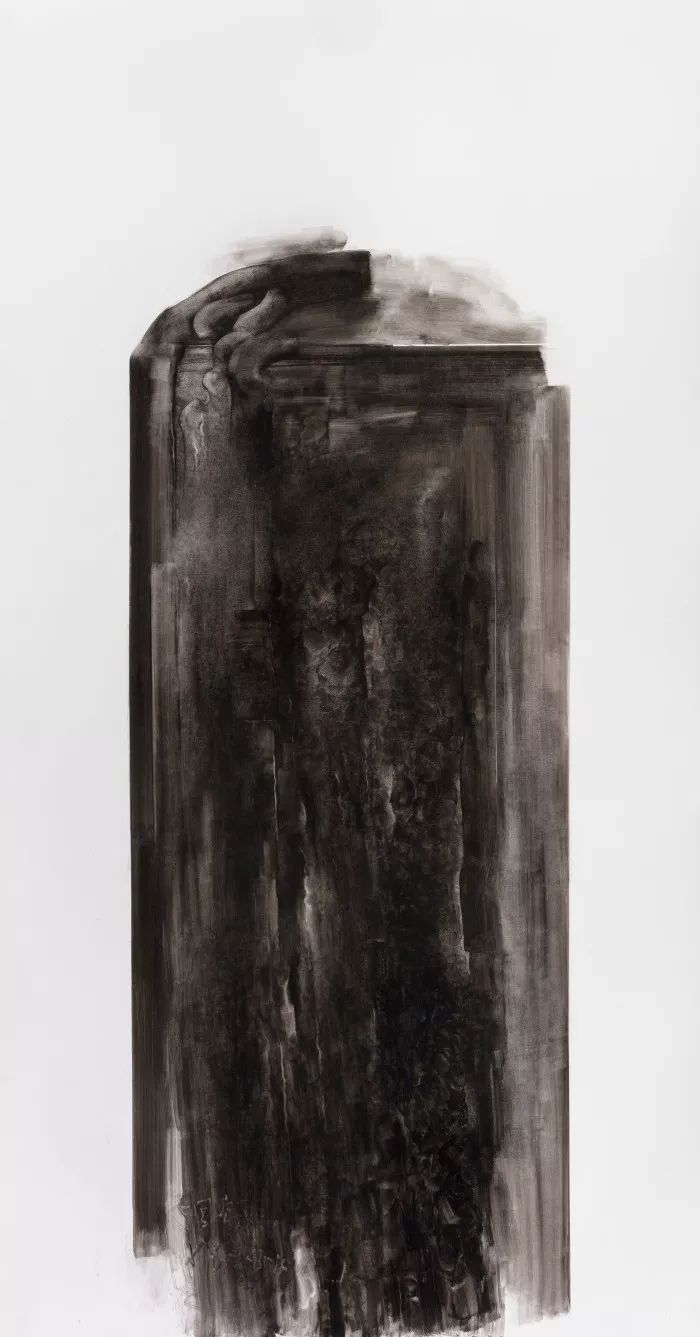
碑痕系列 | Monument Trace series
非宣水墨 | non -Chinese Rise Paper and Ink
128x244cm
2005
Which kind of material can be chosen by artist for their art creation? Does it depend on theartist’s disposition or their human nature, even the affection of the culture?In other words, is the ink art the most appropriate for Chinese people? Itcould be said that everything in this world is born from a particular culturesoil. However, there is a question that why something is universality andothers are not; the answer is about the post-colonial context. The Chinese inkis not a simple painting media; it has a profound philosophical implication and human reverberation. Water is invisible and ink is colorless. Chinese ink painting is abstract in nature. This kind of art is meant to be cosmopolitanart form; however it only ironically became a kind of local art in China.From the connotations of ink and wash, we achieve the negation of reality, break with realism and traditional ideal. Chinese people can't walk out fromtradition, and they can't realize that following the so-called tradition isactually anti-tradition. It is the only possibility that tradition is creative,not to mention that Chinese ink has philosophical opening edge. After 85‘, experimental Chinese ink turned to the other side which use the concept of western paintingas a method to reform the Chinese ink. It ignores the particularity of Chineseink. It may seem that bring countless possibilities for water ink, however, itactually departed from inspirit of water ink. Like new poem against traditionalmandarin, it just a trip of western painting.
The method fromthe outside is only a false method, therefore the modernity that based on which method became pseudo modernity. In a special social and political environment,lack of nutrients must lead to deformity and stagnation of growth. The volution of western art has its own logic of problems. It is a result of the interaction between art and social thought, its motive is directly rooted inphilosophical questioning within art. Chinese ink art is not simply an art categorythat is divided by media, but also by philosophical thoughts and methods.Perfection of art could be achieved through questioning and restoring, acquirerenewal and creation that are accordance with its logic. The presentational ink philosophy is the metaphysical questioning and original thinking about ink and wash. Compare with an inherent concept, this kind of philosophy is so alive that formed a unique spirit of ink through the reflection and betrayal for the tradition.
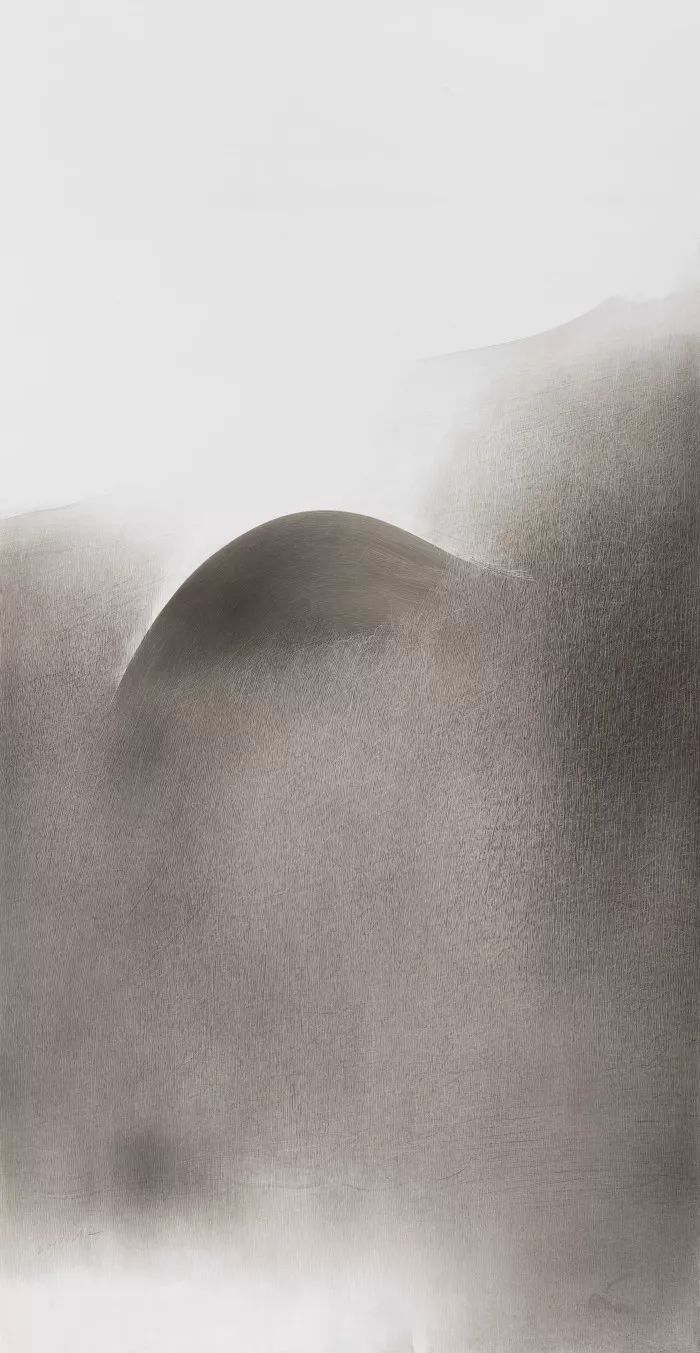
草虬系列 | Wilderness Dragon series
非宣水墨 | non -Chinese Rise Paper and Ink
67x130cm
2017
The creation ofink and wash marks; penetrate into modernity free experience, exploreextremely, making world-shaking statement, the deion like these are only appropriate for Mao Xiaolang, Chinese contemporary artist who have perspectives both in sense of modern and universality. The path that he takes started aself-born of Chinese modern art. He removed the shield of traditional ink art,except metaphysical ink art, tradition does not exist. He weakened the extensity of ink art modeling, what is more, the timeliness, which also knownas progress or marks of Chinese ink became the central of art.
It was not easy for modern art to achieve “image deviation”. The object of space and time are gradually cleared up. As the result, the topic is moved from space to time.From some perspective, modernity focuses on questioning itself about there lationship between existence and time. The different time experience and cognition reflect the essential characteristics of modern experience. Mao Xiaolang’s ink painting has entered a significant category of time modernity.He has a complete and clear cognition with his art practice; his creation follows a trail which includes ink philosophy, method, marks, path, and humannature. He skipped the traditional and ideal concept of ink art, and becomes sobrave that not refers to the world but only refers to himself. “He carves out apath by following his marks.” This is not only because of the sensitivity anddevotion that creative artist has in the modern context, but also because hehas a clear understanding for the irreversible destruction of cultural soilthat caused by a special political and social environment in China. From the perspective of modern semiotics, marks are part of the operation that caused by different element, and made up of the details of the connection of artist’sintuition. Meaning and marks emerge at the same time, the continuous marks reflect the breath of sensible and touchable form which is the life of art.
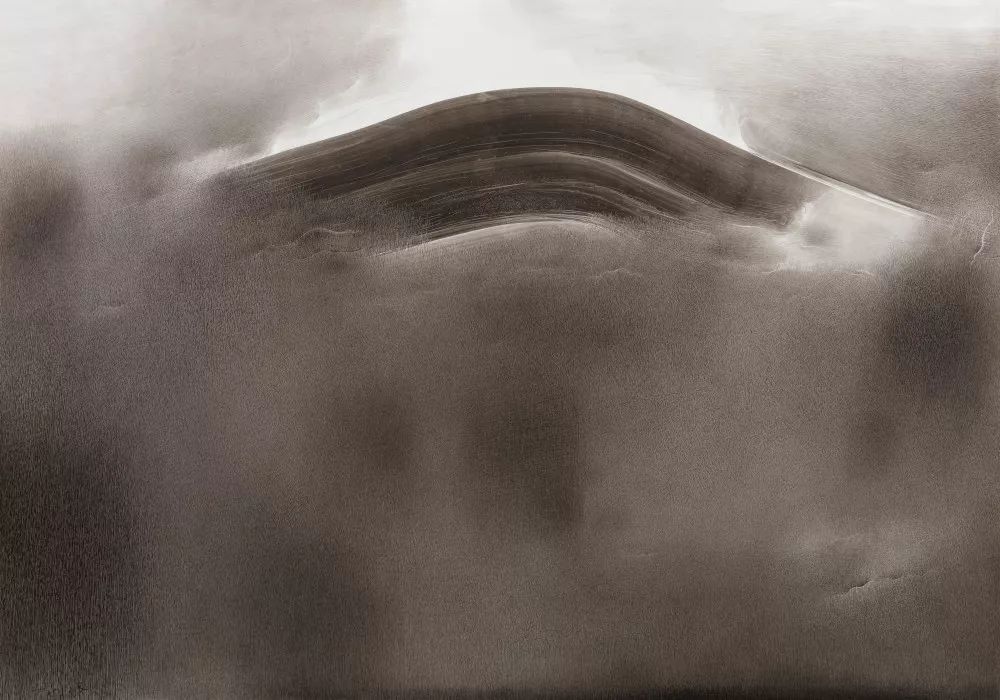
草虬系列 | Wilderness Dragon series
非宣水墨 | non -Chinese Rise Paper and Ink
135x96cm
2017
No matter what changes that the western art had, there is still an invisible metaphysicalspiritual dimension. Art cannot be called “great” without the dimension. Thereal art is supposed to has visibility in invisibility. For instance, there is profound invisibility in Giorgio Morandi’s still life paintings, as well as inMark Rothko’s black paintings. In that way, how many Chinese artists that discover legality to their art works from nothingness? Because of the difference of historical context, it is impossible that Chinese artists achievethis kind of development from western art forms; they only can achieve it from his own nothingness. Mao Xiaolang’s paintings extremely approach the nothingness, reflect his life and nature. Eventually he created a kind of unique art form which not only based on impulse of creation. In China, the artistslike him who have invisible spiritual dimension are the greatest in all artists.
In conclusion,Mao xiaolang’s ink art settled the relationship that between the western artand tradition. His art is does not only belong to China. As an artist, his works don't have Chinese identities, they built a connection that all possibilitiesand others elements, but they never deviate from the spirit of ink painting.
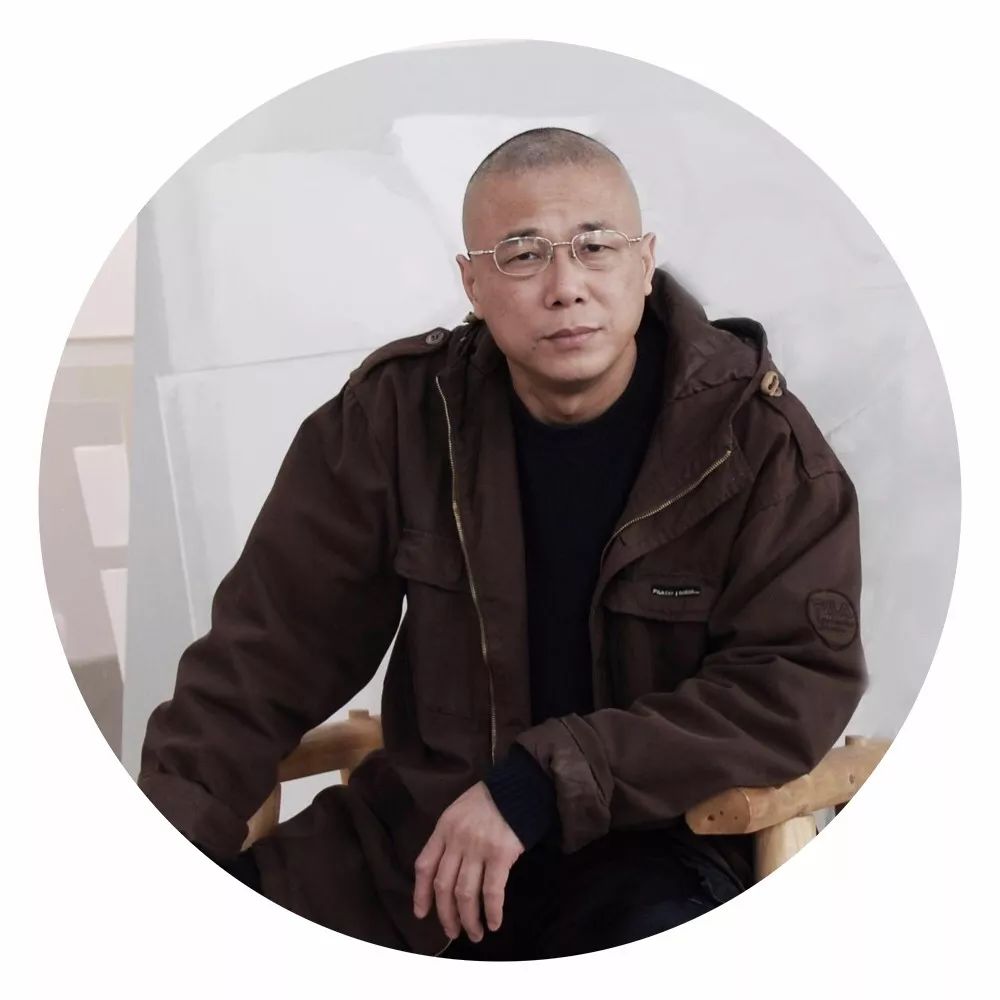
茅小浪 | Mao Xiaolang
1957年生于南京,长期从事实验性绘画及理论的研究,现为自由艺术家及撰稿人。
1991年组织“北京扇形绘画邀请展”并撰写前言;
1993年组织“中国第三语言绘画展”并撰写前言;
1996年组织、策划“开放的语境/南京艺术邀请展”并任学术主持;
2000年组织、策划“中国/ 艺术思想及其行为/ 贰零零零展现”系列艺术活动并任“墨墨墨……展”主持;
2001年组织、策划“重塑社会/ 艺术观念活动”并任学术主持;
2002年组织、策划“幻觉中的自由的中国/ 艺术观念活动”并任学术主持;
2004年组织、策划“寻找黑鸟的故乡”艺术观念活动;
2005年举办北京“碑痕系列——茅小浪非宣水墨展”;
2007年参加北京798K画廊”意外的轻浮——中、加国际艺术交流展”;
2007年参加成都双年展;
2012年参加北京今日美术馆“心性自然——朝向未来的中国绘画”展;
2014年组织、策划“把思想悬挂起来”艺术观念活动;
2015年组织、策划“水墨的自然景象”艺术观念活动;
2018年,“草虬/ 茅小浪非宣水墨”,太和艺术空间,北京;
主要论文:《关于实验性绘画》(《江苏画刊》1987年第8期)、《谈实验性绘画》(《江苏画刊》1988年第7期)、《关于现代绘画材料》(《江苏画刊》1989年第12期)、《谈材料的感觉空间》(《江苏画刊》1991年)、《北京扇形绘画邀请展前言》(《江苏画刊》1991年第5期)、《第三语言》(写于1991年,《中国油画》1993年第3期)、《让问题发言》(《艺苑》1996年第1期)、《对‘无意义’的纪念》(写于1994年,《画廊》1996年第5、6期)《水墨-中国人精神、视觉之大碍》(1996年11月)、《开放的语境》(《美术界》1997年第6期)、《当代艺术探索中的知识分子性》(1997年12月)、《孤独世纪的世纪惊扰》(1997年)、《历史不可沉默-谈王南溟〈字球〉系列》(《画廊》1996年2期)、《穿越物性世界并远离-试论江海的实验主义绘画》(《江苏画刊》1993年第10期)、《十字架下不再缄默-谈高氏兄弟〈十字架〉装置系列》(1997年)、《八五那阵风过去了》(2005年)等数十篇论文。
出版画集:《茅小浪绘画艺术》(南大出版社出版),艺术批评文集《开放的语境》(中国文联出版公司出版)。
1957, Born in Nan Jing, China.Freelance Artist and Writer.
1991, Organized “Invitational Exhibition of Fan-shaped Painting”and contributed the foreword.
1993, Organized “Exhibition of the Third Language of ChinesePainting” and contributed the foreword.
1996, Organizer and curator, “Exoteric Language Environment /Invitational Exhibition of Nan Jing Art”, and served as academic director.
2000, Organizer and curator, art works of “China / ArtisticThought and Behavior / 3000 present “series;Hosted “Exhibition of Ink, Ink, Ink…”
2001, Organizer and curator,“Reshape the Society / Artistic Perception“Activity, and served as academic director.
2002, Organizer and curator, “Free China in Delusion / ArtisticPerception “Activity, and served as academic director.
2004, Organizer and curator, “Searching for Black Bird’sHometown / Artistic Perception” and served as academic director.
2005, “Monument Mark Series—Mao Xiaolang’s non-Chinese Rise PaperInk Painting Exhibition”, Beijing
2007, “Unexpected Flightiness—International Art Exchange Exhibitionof China and Canada”. K Gallery, Beijing.-Chengdu Biennial.
2012, “Human Nature-Toward a Future of Chinese Painting Exhibition”,Today Art Museum, Beijing.
2014, Organizer and curator, “Hanging the Thought up / Artistic Perception”Activity.
2015, Organizer and curator, “Nature Phenomenon of Chinese Ink /Artistic Perception “activity.
2018,Wildness Dragon/ Mao Xiaolang’s Non-rise Paper Ink, Taihe Art Gallery,Beijing.
Major Articles:《About Experimental Paintings》(8th.1987.,《Jiangsu Illustrated monthly》);《Discussion of Experimental Paintings》(7th.1988,《Jiangsu Illustrated Monthly》);《About Material of Modern Paintings》(1989.12nd,《Jiangsu Illustrated Monthly》);《Discussion of Sensorial Space of Painting Material》 (1991, 《Jiangsu Illustrated Monthly》);《the Foreword for Beijing Invitational Exhibition of Fan-shapedPainting》 (5th. 1991, 《Jiangsu Illustrated monthly》);《the 3rd Language》(3rd1993, 《China Oil Painting》);《Let the Problem Speaks》(1st 1996,《Art Magazine》);《Memorial of the “Meaningless”》(5th& 6th 1996, 《Gallery》);《Chinese Ink—An Extreme Boundary for Chinese People’s Spirit and Visual》(11st, 1996, 《Gallery》);《Exoteric Language Environment》(6th1997,《Arts Circle》);《Discussion about the Intellectual Issues in Contemporary Arts》(12nd, 1997);《Interruption in the Lonely Century》(1997);《Can be Silent about History-Discussion about Wang Nanming’s “Word Ball”Series 》 (2nd 1996,《Gallery》);《Through the Animality World and Get Away From It-Discussion aboutJiang Hai’s Experimentalism Paintings》(10th.1993, 《Jiangsu Illustrated monthly》);《No More Silent under the Cross-Discussion about Gao Brothers’<CROSS>Installation Series》 (1997);《85s’Wind Pasts》(2005)
Publishment:《Mao Xiaolang’s Painting Arts,NanjingUniversity Press;Solo Collection of Art Criticism:《Exoteric LanguageEnvironment》,China Federation of Literary and ArtArticles Publishing;2018“the Wilderness Dragon—Mao Xiaolang non-Chinese RisePaper Ink Painting Exhibition”, Taihe Art Gallery, Beijing.